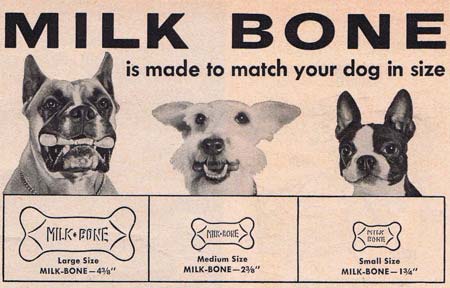Scanning Around With Gene: Is Your Dog Getting Sufficient Eggs?
The place where I shop for dog food is a large feed store where you could, if needed, also buy chow for your llama or duck. The dog food section is bigger than my house and has every conceivable choice, from obscenely expensive high-end all-organic mixes down to cheap bags that take a forklift to move. There is a renaissance going on in the pet-food world, especially when it comes to man’s best friend. The choices are staggering.
Feeding dogs special food is a relatively new phenomenon — the first commercial dog food appeared in the late 1800s but didn’t catch on until much later.
These two modern-day ads are from 1975 and 1967. Click on any image in this column for a larger version.


The earliest ads I could find for national-brand pet food among my unscientifically selected pile of vintage magazines were these from 1937 and 1939. Both played off of the nutritional and medical reasons to buy special food for your dog. And it is likely many dogs were malnourished at that time, either from lack of food or ignorance regarding their nutritional needs.


It was an American named James Spratt, living in London, who is widely credited with inventing commercial dog food in the late 1800s. By 1907 we had Milk Bones and a number of commercial dog-food suppliers, often made by local mills along with other animal foods.




As one way to deal with large numbers of dead horses after World War I, the Quaker Oats Company introduced the Ken-L-Ration brand of canned dog food in the 1920s.



But it wasn’t until after World War II that pets and pet food really took off. Lots of new young families and adorable puppies. Convenience and urban living helped popularize commercial dog food.



The biggest breakthrough came in 1957, when the Purina Company invented a new extrusion method for making dog “pellets” in uniform size and shape. The company’s Purina Dog Chow brand was a huge success and quickly gained market share. And yes, the word “Chow” is a registered trademark of Purina.



Dry or canned? The answer to that age-old question, plus many more vintage ads, is on page 2.


I had forgotten about Gaines Burgers. Just the mere mention of the name gave me flashbacks to being a kid (probably 1980 or so) and unwrapping the cellophane of a “burger” to feed to my Irish Setter!
Thank you for this great post, I love the pictures classic.
Man, I remember the Gaines Burgers, crumbling them up for our dalmation. And the little treats made to look like bones with marrow in the middle. Anyone else remember Liv-a-Snaps? We always had a box of those, though I don’t remember her being interested much in them. My favorite was always the biscuits made to look like the canine version of animal crackers–they came in Mailman, Dog Catcher, Milkman and 1 or 2 other shapes I can’t remember. Yes Gene, I’d have to agree that the pooches are much better off nutritionally now. Thanks for the memories!
Resources like the one you mentioned here will be very useful to me! I will post a link to this page on my blog rental mobil jakarta . I am sure my visitors will find that very useful